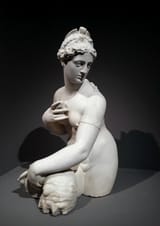Search Results
7/14/2025, 6:47:43 PM
On October 14, 1775, Patch requested an export license to sell the work to someone identified only as “an elderly English gentleman,” and on November 20, the export license was granted. Thereafter the sculpture remained in England, misidentified by the time it was owned by a private collector around 1950; it was reattributed to Giambologna only after it appeared on September 13, 1989, having been consigned by Charles Worley of London to Christie’s Wrotham Park sale, where it was catalogued as “an eighteenth-century white marble half-length figure of Venus Marina.”
In 1584, poet and art critic Raffaello Borghini vividly described “a grotto made with great artifice, everything charmingly painted inside, [the water] falling into a large oval basin with a delightful sound. Above the basin that receives water, a most beautiful nude woman made out of marble by Giambologna in the act of leaving a cave; one hand is placed on her delicate breast and the other supports a seashell from which the water rises and falls back in to the basin, so it looks like quicksilver; and this beautiful woman represents the ‘Fata Morgana’ (after whom in ancient times the spring was named).”
In 1584, poet and art critic Raffaello Borghini vividly described “a grotto made with great artifice, everything charmingly painted inside, [the water] falling into a large oval basin with a delightful sound. Above the basin that receives water, a most beautiful nude woman made out of marble by Giambologna in the act of leaving a cave; one hand is placed on her delicate breast and the other supports a seashell from which the water rises and falls back in to the basin, so it looks like quicksilver; and this beautiful woman represents the ‘Fata Morgana’ (after whom in ancient times the spring was named).”
Page 1
